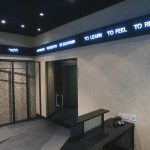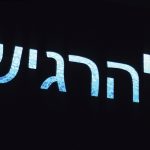

Née à Arthabaska, Lisette Lemieux a d’abord complété un baccalauréat en pédagogie à l’Université de Sherbrooke avant d’entreprendre des études en arts. Elle détient un baccalauréat ès arts de l’Université Laval, une licence en histoire de l’art de l’Université de Montréal, un baccalauréat et une maîtrise en arts plastiques de l’UQAM.
Depuis 1975, elle a participé à de nombreuses expositions individuelles et collectives au Québec et à l’étranger. Elle a également réalisé plusieurs œuvres d’art public, notamment Transcription 92 (1992) au centre Pierre-Péladeau et Kristallnacht (Nuit de cristal) (2003) au Musée de l’Holocauste Montréal. En 2006, son œuvre Liber a été offerte par la Ville de Montréal à l’UNESCO, à l’occasion de l’événement Montréal, capitale mondiale du livre.

Artwork description
The work takes the form of a frieze running along the walls of the Montreal Holocaust Museum’s entrance. This black frieze is pierced with the words TO LEARN – TO FEEL – TO REMEMBER in French, English, Hebrew and Yiddish. The words are read in a continuous visual sequence from left to right and from right to left, respecting the order of Semitic readings. Behind these words is a pane of broken glass, illuminated with neon lights, which evokes Kristallnacht, the night of broken glass in November 1938. The script chosen for the words references stencils that are used to label goods for shipping, recalling the movement of dark convoys leading hordes of humans to their tragic fate. The cracks around the heavy edges of the dark frieze let in the light of these “wandering nights” (imagery borrowed from Théophile Gauthier). The transition from darkness to light is also suggested by the gradient background behind the glass pane. Hope rises from the depths of the abyss. The installation of a cold-tone neon lighting system, accentuated by the murky colour of the shattered glass, helps to create an atmosphere reminiscent of these tragic events.



